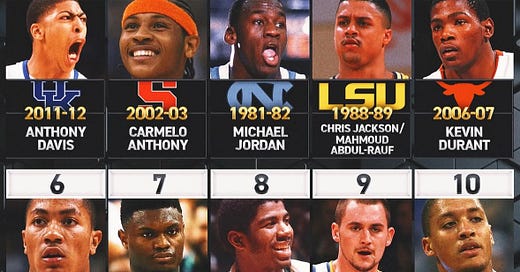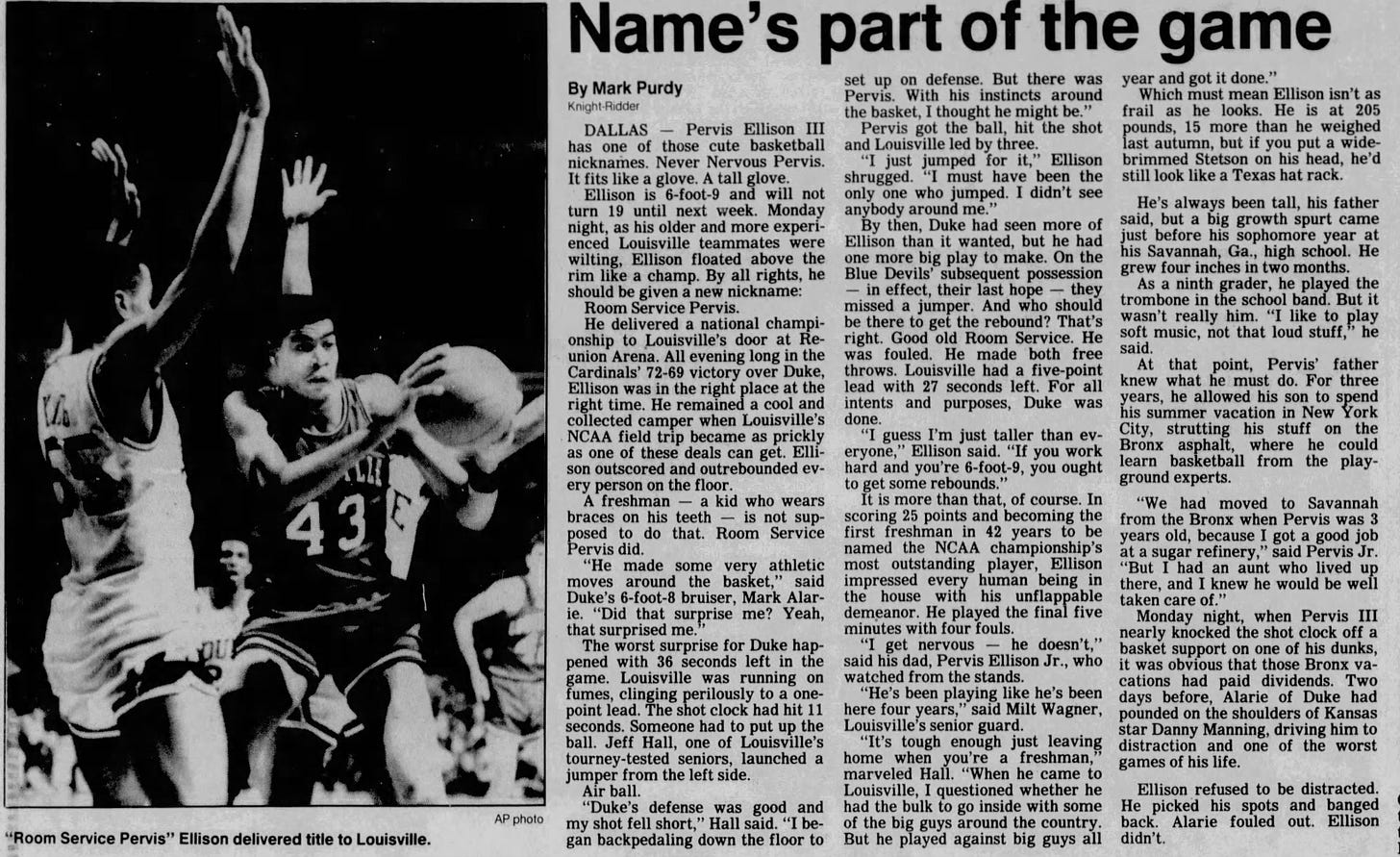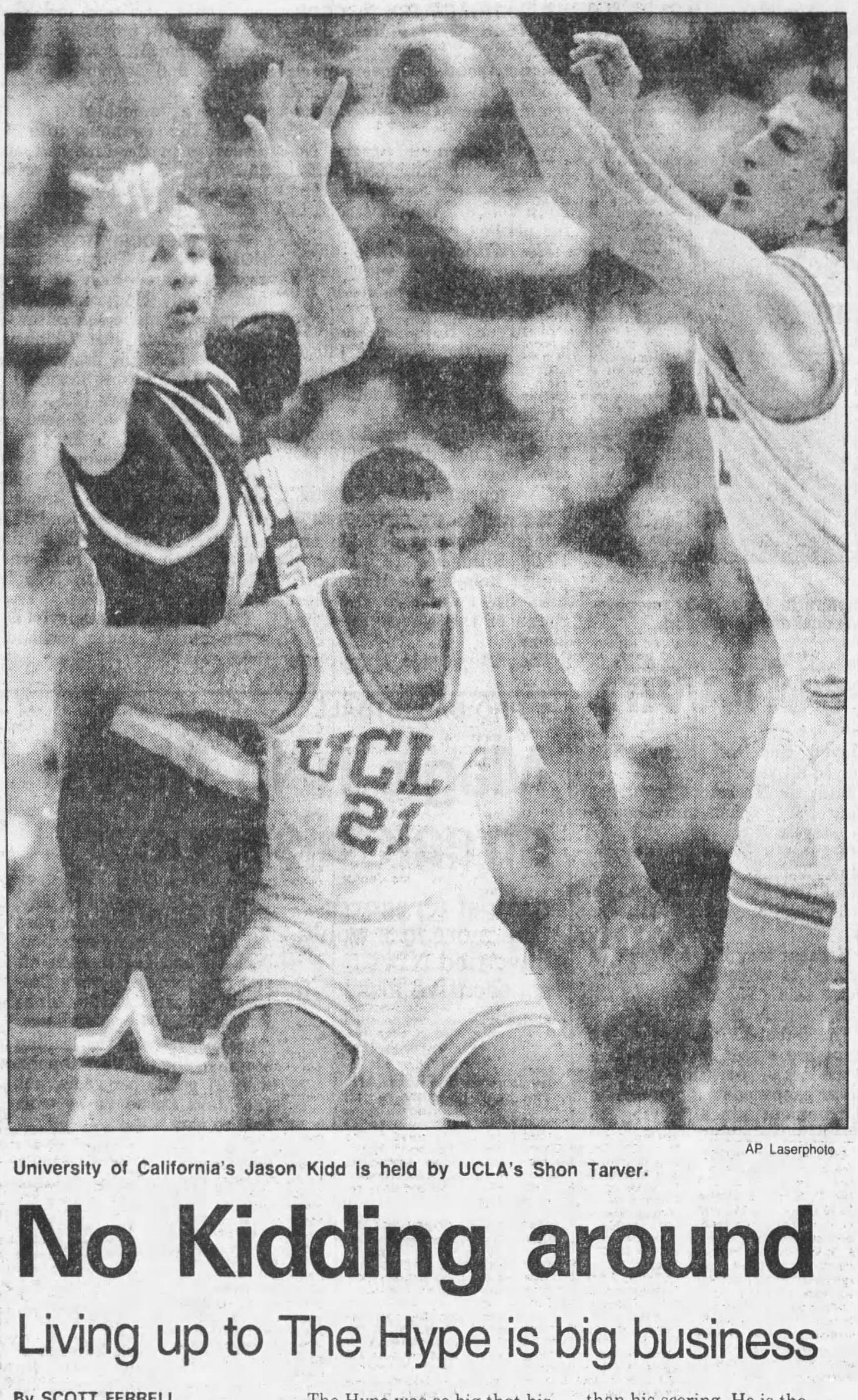Top Tuesday 10 Takes The Bait: No Fox, Michael Jordan Did Not Have A Top 3 Freshman Season
Top 10 Tuesday offers up 10 all-time great college basketball freshmen who had better individual first years than Michael Jordan or Derrick Rose.
Longtime, or even recent, return readers of The Press Break know I’m a fan of The Simpsons. So much of the series' initial decade or so offers up gags that apply as much to life in 2025 as they did when introduced three decades ago. One such relevant joke today, made in the Treehouse of Horror episode "Just Don’t Look," features rampaging advertising mascots destroying Springfield until Lisa and Paul Anka collaborate on the catchy, titular jingle.
The tune is a reminder that annoying, and perhaps even destructive, content only gets power when the masses give it attention. I try to live by that philosophy in my own life, so please forgive me for basing this edition of Top 10 Tuesday on Instagram rage-bait. But I can at least explain.
I don’t follow any Fox Sports accounts, but that doesn’t mean the Instagram algorithm doesn’t feed Fox content to me. I’ve seen a number of its Ranker posts before and usually ignore them. However, the topic of all-time outstanding freshman seasons has been something I’ve kicked around as a potential entry for The Press Break.
As such, I had already compiled a fair bit of research and began fleshing out categories such as Best Freshman NCAA Tournament Performances, Best Freshman Seasons Pre- and Post-One-and-Done Rule, etc. After all, I love a good list.
But this list? Not a good list. I also felt undercut, so I had to break my personal rule of not bringing more attention to bad content in order to put Fox in its place.
Now, a general rule when debating lists is to specify entries that can be removed in order to make room for omissions. So, with that, I remove Michael Jordan, who had a good freshman season but not a top 10 all-time campaign; and certainly not a top three freshman season.
Jordan’s game-winning shot in the National Championship Game against Georgetown inflates the perception of his 1981-82 campaign — and the fact that he’s Michael freakin’ Jordan. But at 13.5 points, 4.4 rebounds, and 1.8 assists per game, even with the ACC Rookie of the Year award to his credit, Jordan was the third option on a loaded North Carolina team.
Derrick Rose also gets the boot. Rose played his best basketball of the season during Memphis’ run to the 2008 National Championship Game, capping a great freshman year with 14.9 points, 4.7 assists, and 4.5 rebounds per game. But Rose also committed 2.7 turnovers per game, and as anyone who followed the 2007-08 season knows, he ran a distant second as the best freshman of the class to Kansas State’s Michael Beasley.
Rose proved to be the better NBA prospect, but that does nothing to negate the fact that Beasley had a freshman season worthy of top five all-time consideration.
I’ll still get around to those Best Freshman Seasons categories. In the meantime, here are suggestions to take over at least two vacancies from a Top 10 list that badly needs a re-ranking.
Editor’s Note: Wayman Tisdale will get his own entry.
Mark Aguirre, DePaul (1978-79)
It’s quite possible that DePaul had freshmen in back-to-back seasons worthy of inclusion among the best-ever first-year campaigns. In 1979-80, power forward Terry Cummings debuted for the Blue Demons, averaging 14.2 points per game on 50.8 percent shooting from the floor, grabbing 9.4 rebounds per game, and blocking 1.4 shots per game.
As excellent as Cummings was coming to DePaul from Carver Military Academy, though, his freshman season doesn’t match that of Mark Aguirre.
The local Chicago high school standout Aguirre was an immediate sensation for the Blue Demons, leading the 1979 Final Four team in scoring at 24 points per game in an era predating the 3-point line. He was second on the team in rebounding at 7.6 a contest, and led DePaul with 1.3 steals per game.
Kenny Anderson, Georgia Tech (1989-90)
Georgia Tech reached its first-ever Final Four in 1990 behind the perimeter combination nicknamed Lethal Weapon 3: Dennis Scott, Brian Oliver, and the freshman phenom Kenny Anderson.
Among the history-rich New York high school basketball scene’s greatest prep players ever, Anderson trekked South from Archbishop Molloy and treated the ACC like he did Big Apple high school teams.
Anderson averaged 20.6 points per game on 51.2 percent shooting from the floor, including a blistering 41 percent from 3-point distance. Anderson was also the driving engine for an offense that facilitated both Scott and Oliver averaging more than 20 points per game, dishing out 8.1 assists per game.
Pervis Ellison, Louisville (1985-86)
A generation before Carmelo Anthony and Anthony Davis led Syracuse and Kentucky to national championships as freshmen, Pervis Ellison stood tall as the first frosh to win Most Outstanding Player of the NCAA Tournament.
Ellison earned the nickname “Never Nervous” for the veteran savvy he showed on the way to Louisville winning the 1986 national championship, putting up double-doubles in the Elite Eight, national semifinal, and an outstanding 25 points on 10-of-14 shooting from the floor with 11 rebounds in the National Championship Game vs. Duke.
Now, March Madness runs alone do not warrant inclusion among the greatest freshman seasons ever, since we’re recognizing players’ complete campaigns. But Ellison’s historic NCAA Tournament was the culmination of an impressive debut season in which he was vital to Louisville’s success, particularly on the boards and defensive end.
Ellison led the Cardinals with 8.2 rebounds and 2.4 blocked shots per game, and matched Milt Wagner Jr.’s 1.3 steals per game for team-high honors. At 13.1 points per game on 55.4 percent field-goal shooting, Ellison was a reliable offensive weapon too.
Tyler Hansbrough, North Carolina (2005-06)
Tyler Hansbrough’s time at North Carolina shares certain parallels with that of Tim Tebow when the quarterback was at Florida. Their college careers mostly overlapped, with Tebow’s time as a Gator ending in the January 2010 Sugar Bowl, nine months after Hansbrough captained the Tar Heels to basketball’s national championship.
The two were similarly covered in the media — which was, in a word, breathlessly — to the point of oversaturation. The resulting exhaustion prompted backlash that I feel has unfairly slighted how Hansbrough’s career is viewed outside of North Carolina’s faithful. I dare say the backlash began even when Hansbrough was still a Tar Heel; his losing out on the 2009 NCAA Tournament Most Outstanding Player to Wayne Ellington always felt a little odd to me.
Anyway, for one reason or another, Tyler Hansbrough doesn’t seem to be fondly recalled in a way befitting a career that included such milestones as an incredible four All-American selections. That obviously includes his freshman season, when Hansbrough exploded into the role Sean May previously occupied for the defending national champions.
Hansbrough averaged 18.9 points on 57 percent shooting from the floor, grabbed 7.8 rebounds, and made 1.2 steals per game for a North Carolina team projected to be rebuilding, that instead finished second in the ACC. He also set a Tar Heels freshman record with 40 points in a win over Georgia Tech.
Jason Kidd, Cal (1992-93)
Even in the 20 years since the NBA instituted the One-and-Done age-limit rule, freshmen winning major conference Player of the Year honors remains an anomaly. Before Kevin Love did so in 2007-08, the only freshman to claim Pac-12 Player of the Year was Jason Kidd in 1992-93, beating out such competitors as UCLA’s Ed O’Bannon and Arizona All-American Chris Mills.
Kidd averaged 13 points per game in 1992-93, but more importantly, led the Pac-10 with 7.7 assists per game, and led the nation in steals at 3.8 per game. His 110 swipes is still the NCAA freshman record.
“Jason can dominate a game without ever scoring a point. That’s the ultimate compliment you can give a player,” Golden Bears coach Todd Bozeman said of Kidd in 1993.
Stephon Marbury, Georgia Tech (1995-96)
In the lineage of sensational New York City point guards, perhaps the most nationally celebrated before his college debut was Stephon Marbury. SLAM Magazine dedicated plenty of words to Marbury’s exploits at Lincoln High School on Coney Island, and the public-school team became so prominent on the New York scene that Spike Lee included the Railsplitters in his 1998 film He Got Game.
No shortage of hype followed Marbury as he followed Kenny Anderson’s move from New York City to Atlanta and Georgia Tech. And while Marbury’s Georgia Tech team didn’t replicate Lethal Weapon 3’s Final Four run, Marbury willed a significantly less talented lineup to the Sweet 16.
His 29-point, nine-assist, and four-steal performance in a Round of 32 win over Boston College was perhaps the best game of Marbury’s entire Georgia Tech tenure, but his entire freshman campaign was excellent all the way around. Marbury averaged 18.9 points, shot 37 percent from 3-point range, doled out 4.5 assists, and swiped 1.8 steals in 1995-96.
Greg Oden, Ohio State (2006-07)
On the topic of professional careers that did not live up to expectations, the first from the 21st century NBA that might come to mind is that of Greg Oden. It’s one of those topics that, if you weren’t plugged in at the time, seems inexplicable today. How could Oden have gone No. 1 overall in the 2007 NBA draft ahead of Kevin Durant, who had one of the greatest freshman seasons ever at Texas and has since become a first-ballot Basketball Hall of Famer?
The Oden vs. Durant situation wasn’t a 21st-century version of the Sam Bowie-Michael Jordan fiasco, though. While Durant did indeed have an all-time great freshman season down in Austin, Greg Oden was exceptional in his one season at Ohio State.
Oden was a force on the interior, leading the Big Ten Conference in rebounding (9.6 per game), blocked shots (3.3), and field-goal percentage (61.6). Oden leveraged his field-goal shooting into a solid 15.7-point per game average.
His all-around game and impressive, if not deceptive, athleticism gave Oden an aura that felt a bit like Tim Duncan. Unlike Duncan, Oden garnered All-American honors as a freshman — and, unlike his contemporary Durant, Oden led his team out of the first weekend of the NCAA Tournament and all the way to the National Championship Game.
It’s unfortunate that injuries doomed Oden to never really play again, but his March 2007 was otherworldly: He won Big Ten Tournament MVP with a performance that included a 17-point, 19-rebound, four-block showing vs. Purdue; then, in March Madness, Oden put up three double-doubles, including one of the most memorable National Championship Game performances of the 21st century with 25 points, 12 rebounds, and four blocks vs. Florida.
Ralph Sampson, Virginia (1979-80)
Ralph Sampson’s NBA career was not as plagued as Oden’s, which might make Sampson’s eventual fading away all the more unfortunate. The league caught a glimpse of a healthy Sampson, the only three-time National Player of the Year since Bill Walton, when he averaged a double-double in each of his three full NBA seasons.
Sampson came into the NBA with remarkable hype and, as the 1983-84 Rookie of the Year, lived up to it. It wasn’t his first impressive debut season in high-level basketball, either, after winning the 1980 ACC Rookie of the Year. Sampson averaged 14.9 points per game as a freshman, led the conference in rebounding at 11.2 per game, and led the nation with what ended up being a career-high 4.6 blocked shots per game.
Chris Webber, Michigan (1991-92)
How does the star of the greatest collection of freshman talent ever assembled in college basketball history not get recognized among the best-ever freshman seasons? HOW?!
Michigan’s Fab Five was transcendent in so many ways, both with its immediate on-court success when the quintet debuted in 1991-92, and its cultural influence. Those baggy-shorts maize uniforms paired with black shoes and socks became iconic — and that certainly wouldn’t have been the case if the Fab Five lacked the production to match the swagger.
They delivered, alright. Although the Wolverines ran into a buzzsaw against Duke, on its way to a repeat national championship, Michigan reaching the title game with an all-freshmen starting lineup remains a remarkable feat, not duplicated even as college basketball trended younger post-One-and-Done rule.
Perhaps it was his falling out with other members of the Fab Five, exacerbated by Jalen Rose’s media prominence. Maybe it’s the timeout technical foul in the 1993 National Championship Game being the enduring memory of his college career. Whatever the reason, C-Webb’s role as the alpha of the Fab Five feels glossed over 30 years later.
It shouldn’t be. Webber was a monster and the undisputed star for Michigan in his two seasons there, including a freshman campaign in which he averaged a double-double at 15.5 points and a Big Ten-leading 10 rebounds per game. He also blocked 2.5 shots and made 1.6 steals per game to fuel the Michigan defense.
In the Wolverines’ run to the Metrodome, site of the 1992 Final Four, Webber kicked off a run of three straight NCAA Tournament double-doubles with a 23-point, 11-rebound, and five-block performance in an Elite Eight defeat of the Jim Jackson-led Ohio State Buckeyes.
That performance alone against the school’s bitter rival should have Michigan fans screaming for Webber as having had a top 10 all-time freshman season.
Trae Young, Oklahoma (2017-18)
Of all the above omissions, Trae Young’s surprised me the most. His freshman season at Oklahoma is recent enough that the fresh-from-college intern likely tasked with producing Fox’s Top 10 would have been old enough to remember watching Young play.
Young’s still a relevant NBA superstar today. And, what’s more, his 2017-18 campaign was pretty much bonkers.
There was not insignificant chatter online during Young’s run with the Sooners suggesting he was having not just the best freshman season ever, but perhaps one of the greatest college basketball seasons of all time.
Oklahoma proved too one-dimensional to contend in the 2018 Tournament after barely squeaking into the field. Perhaps that hurts perception of Young’s freshman season, but it doesn’t negate that he led the nation in both scoring (27.4 points per game) and assists (8.7 per game).









Great list. And one vote for Mark Macon (Temple, 1987-88): Second-team All-American, nearly 21 points per game as a freshman.